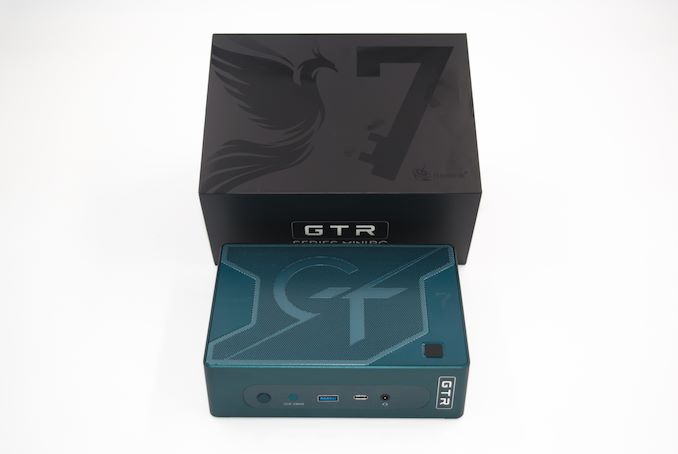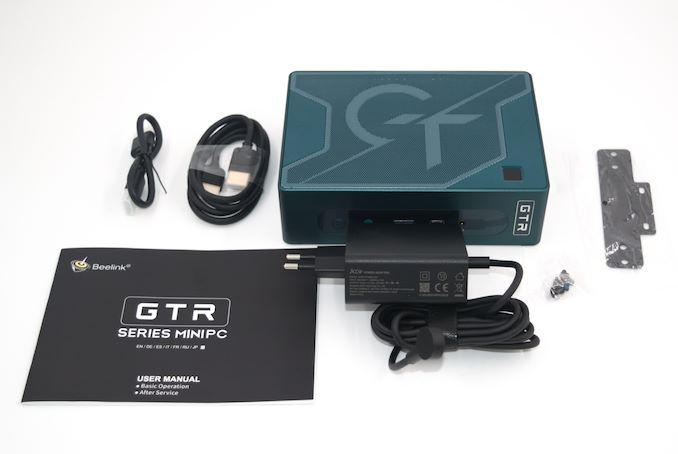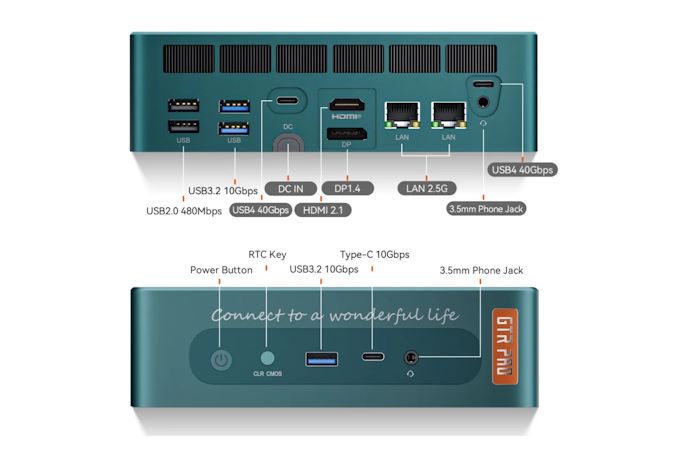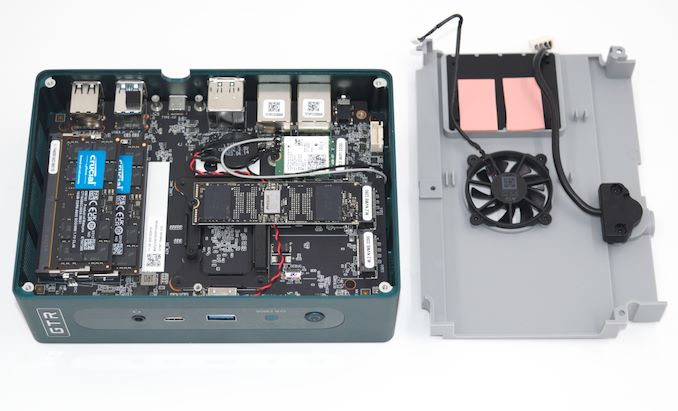Beelink GTR7 mini-PC Review: A Complete AMD Phoenix Package at 65W
by Ganesh T S on August 24, 2023 8:00 AM EST
The increasing popularity of small form-factor (SFF) PCs has allowed a number of second and third tier vendors to market their wares. While the trend was kickstarted by the Intel NUC in the early 2010s, recent years have seen various Asian companies such as Beelink, Chuwi, GEEKOM, MinisForum, etc. focus solely on these types of systems. Beelink has been slowly gaining popularity over the last five years or so with their wide range of products using the latest processors from Intel and AMD.
The high-performance UCFF / SFF PC market had been cornered by Intel processors for many years. Even after its resurgence with the Zen microarchitecture, AMD opted to focus on the high-performance desktop and server markets first. The mobile products based on each microarchitecture generation often launched with a delay of many quarters, but the gap has slowly been whittled down. Desktop Zen 4 Raphael launched in mid Q3 2022, while the mobile-focused Phoenix lineup launched in early Q1 2023. Over the last few years, we have seen vendors finally getting to introduce UCFF and SFF PCs based on mobile Zen silicon with a delay after the launch of corresponding notebooks. With Zen 4-based Phoenix, we are finally seeing mini-PCs and laptops almost launching simultaneously.
Beelink became one of the first vendors to launch an AMD Phoenix (Zen 4 CPU + RDNA3 iGPU in a power envelop suitable for notebooks) mini-PC lineup when they announced the GTR7 product line. The company sent over their entry-level version - the GTR7 7840HS - to put through our evaluation routine for small form-factor systems. Beelink is touting the use of vapor chamber-based cooling, allowing the Ryzen 7 7840HS to be configured with a 65W TDP (compared to the 35W-54W cTDP specified by AMD). The company also includes active cooling support for the RAM and a dedicated thermal solution for the SSDs. The GTR7 also provides many connectivity options - including five Type-A ports, and three Type-C ones (of which two are USB4 40 Gbps with full PCIe tunneling support). The system can support four simultaneous displays and also includes two 2.5 Gbps LAN ports. To top it all, the system also includes a fingerprint scanner on the top panel, and a secure power cable connector (magnetic) - all of this in a 6.61in x 4.72in x 1.92in package that is not much larger than a NUC.
The specifications and feature set of the GTR7 7840HS appears impressive, but initial reviews were not too kind. While there were some issues related to the GPU drivers and overheating in our initial testing (that resulted in the review getting delayed), we are happy to report that the latest drivers from AMD coupled with a new bottom panel (with perforations aligning with the system fan) completely resolved the roadblocks we faced. As a result, we are able to present this detailed review exploring the performance profile and value proposition of the Beelink GTR7 7840HS.
Introduction and Product Impressions
The majority of desktop deployments in the 2000s were unwieldy and in some cases, over-powered, for their use-cases. The advent of powerful processors in the early 2010s enabled mobile CPUs in ultra-compact and small form-factor systems to replace some of these bulky desktops. The rapid growth in this segment has created a number of companies focusing on UCFF and SFF desktop systems.
Most electronic products are brought to market with help from OEMs and ODMs. For example, early NUC systems were designed by Intel and sold under their brand name, but the actual manufacturing was done by Elitegroup Computing Systems (ECS) with the latter acting as the ODM (Original Design Manufacturer). On the other hand, Original Equipment Manufacturers (OEMs) design and manufacture the products, but allow other companies with marketing reach and distribution channels to present them under their own brand name. In some cases, OEMs create their own brands. Beelink is a private label brand of Shenzhen AZW Technology Co., Ltd.. The company manufactures both Intel and AMD-based systems.
Beelink has a relatively long history of marketing mini-PCs based on mobile Ryzen SoCs. Starting with the GTR based on the Ryzen 3000H series in late 2020, the company iterated quickly to release the GTR4 (Ryzen 4000H), GTR5 (Ryzen 5000H), and more recently, the GTR6 (Ryzen 6000HX) in November 2022. Now, the company has started to ship the GTR7 lineup based on the AMD Ryzen 7040HS Phoenix silicon. All the GTR systems came in a similar cuboidal form-factor. The company also created a lineup of Ryzen-based UCFF systems under the SER tag, but our focus in this piece is on the GTR line.
Beelink's package components for the GTR7 7840HS include a VESA / wall mounting kit, user manual, a 120W (19V @ 6.32A) DC adapter, and two HDMI cables. The system is offered in a variety of colors, and our sample was dark green.
The mounting kit is not entirely VESA-compliant, but it can hang off two screws on the back of a VESA-compliant monitor (Beelink prefers to refer to it as a wall-mounting kit). The power adapter seems to be based on Gallium Nitride (GaN) technology, given its physical footprint and output wattage. It is nice to finally see mini-PC vendors realize the user-friendliness of compact power adapters. Short of accepting USB-C PD inputs, this is probably the best that can be done. While we received the EU version of the adapter in our review sample, we believe it is localized to the country of sale. The other end of the adapter is unfortunately a proprietary magnetic clamp that fastens firmly to the base of the main unit.
The main unit itself has a well-ventilated chassis. The perforations on the top allow the radiator fan placed to get rid of the heat from the vapor chamber to draw in cold air and direct it towards the heat dissipating radiator fins. The rear of the chassis has openings for the air exhaust through these fins, and the I/O ports are arranged below that.
One of the interesting aspects of the I/O ports is the presence of an audio jack in both front and rear panels. Beelink has designed this in such a way that the connection of a headset of speakers to the rear jack automatically disables the front one. Both audio jacks are serviced by the same Realtek ALC897 audio codec.
The underside of the chassis is slightly raised and fastened to the main chassis with four screws. Our initial sample had a completely solid rectangular slab for this underside, but the company later sent out a replacement underside which included perforations directly under the fan placed in the internal shroud. A detailed description along with pictures is available in the section dealing with the thermals.
The shroud is fastened to the main board using three screws, and they need to be removed in order to access the two M.2 2280 SSD slots and the DDR5 SODIMM slots.
Beelink sells systems ready out-of-the-box, i.e, with RAM and SSD pre-installed, and loaded up with Windows 11 Professional. Our review sample was equipped with 2x Crucial CT16G56C46S5 DDR5-5600 SODIMMs and a Crucial P3 Plus Gen4 x4 M.2 2280 NVMe SSD. The full specifications of the review sample (as tested) are summarized in the table below. The Ryzen 7 7840HS has a configurable TDP (cTDP) ranging from 35W to 54W. As we shall see in our detailed investigation into the thermal characteristics in a later section, the high-end vapor chamber-based thermal solution allows the operation of the Phoenix SoC in a 65W cTDP mode.
| Beelink GTR7 Specifications (as tested) |
|
| Processor | AMD Ryzen 7 7840HS Zen 4 (Phoenix) 8C/16T, 3.8 - 5.1 GHz TSMC 4nm, 16MB L3, 35-54W Target TDP : 65W |
| Memory | Crucial CT16G56C46S5.M8G1 DDR5-5600 SODIMM 46-45-45-90 @ 5600 MHz 2x16 GB |
| Graphics | AMD Radeon 780M (RDNA3 / Phoenix) - Integrated (12 CUs @ 2.7 GHz) |
| Disk Drive(s) | Crucial P3 Plus CT1000P3PSSD8 (1 TB; M.2 2280 PCIe 4.0 x4 NVMe;) (Micron 176L 3D QLC (N48R); Phison E21T Controller) |
| Networking | 2x 2.5 GbE RJ-45 (Intel I225-V) Intel Wi-Fi 6 AX200 (2x2 802.11ax - 2.4 Gbps) |
| Audio | Realtek ALC897 (3.5mm Audio Jacks in Front and Rear) Digital Audio with bitstreaming support over HDMI, Display Port, and Type-C |
| Video | 1x HDMI 2.1 (4Kp120) 1x Display Port 2.1 (4Kp120) 2x Display Port 2.1 over USB4 Type-C (4Kp120) |
| Miscellaneous I/O Ports | 1x USB 3.2 Gen 2 Type-A (Front) 1x USB 3.2 Gen 2 Type-C (Front) 2x USB4 Type-C (Rear) 2x USB 3.2 Gen 2 Type-A (Rear) 2x USB 2.0 Type-A (Rear) |
| Operating System | Windows 11 Enterprise (22000.2245) |
| Pricing | (Street Pricing on Aug 19th, 2023) US $709 (as configured, with OS) |
| Full Specifications | Beelink GTR7 7840HS Specifications |
The next section details the the various BIOS options and follows it up with a detailed platform analysis.













55 Comments
View All Comments
lemurbutton - Thursday, August 24, 2023 - link
You can get a M2 Mini for $499 on sale. It's superior to this in just about every way. Even if you upgrade the RAM for $200, it's still better than this. Faster CPU, faster GPU, has AI inference, faster RAM, significantly lower power requirements. Replymeacupla - Thursday, August 24, 2023 - link
Well, yeah, obviously the $499 M2 mini is cheaper.It's a weaker PC than this, in every single metric.
It only has 8GB of RAM, 128GB SSD, both of which cannot be upgraded later on.
It's CPU and GPU are weaker than a 7840HS. To top it off M2 runs less efficiently and hotter.
Which is exactly why no one is buying it, and Apple had to halt M2 production. Reply
ingwe - Thursday, August 24, 2023 - link
The mac mini has a 256GB SSD. Probably doesn't really need the ram upgrade. But...upgrading the SSD to 1 TB is $400. And not sure what you are saying about the M2 running less efficiently. Mac Mini is a fine option imo. But I would much rather have the GTR7 for a lot of reasons. Would be great for a streaming PC and console replacement for older games. ReplyPixyMisa - Thursday, August 24, 2023 - link
You can buy two 4TB SSDs for $400. Replyqwertymac93 - Thursday, August 24, 2023 - link
Does it run Windows 11 pro? Replybji - Thursday, August 24, 2023 - link
Why in the world would anyone *want to* though? ReplyTheinsanegamerN - Thursday, August 24, 2023 - link
Point taken, but so long as apple keeps doing its walled garden BS people will continue to rely on other OSes. ReplyActionJ26 - Friday, August 25, 2023 - link
Why would anyone want to use iOS. My last company did and compared to Windows it is trash. Never thought I would say that. Some much of the functionality requires store bought add ones. Replydarkswordsman17 - Friday, August 25, 2023 - link
Er, Mac Mini runs MacOS, not iOS. ReplyGm2502 - Friday, August 25, 2023 - link
Games, productivity or anything else the VAST majority of the world does when they don't have to run on a proprietary, non-upgradable glorified mobile phone. This Miniforum is superior in EVERY metric mate, so take your fan boy rubbish elsewhere. Reply